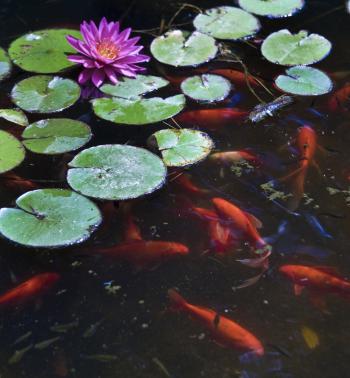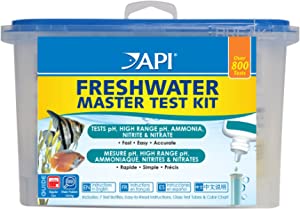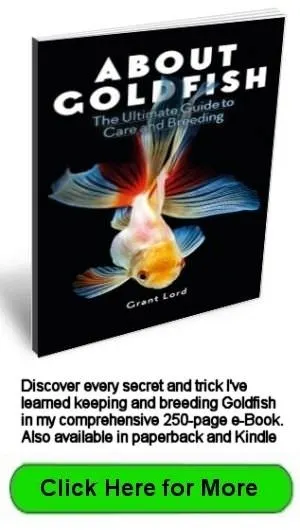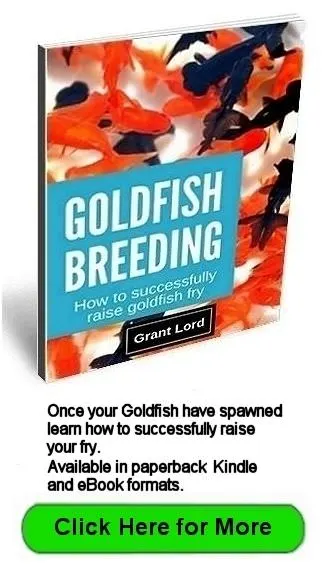Goldfish Pond Maintenance
Goldfish pond maintenance is similar to aquarium maintenance, only on a larger scale.
 Goldfish pond filled with Common Goldfish, lilies and Gambusia (mosquito fish)
Goldfish pond filled with Common Goldfish, lilies and Gambusia (mosquito fish)Regular Goldfish pond maintenance is probably more important than aquarium maintenance because of the work involved if a complete pond clean out is required.
A pond is a more natural environment for goldfish than an aquarium, but the fish numbers are usually much higher than in a natural pond or slow running stream, so regular maintenance still needs to be done.
Water Testing Tells You When To Do Maintenance
Testing the water with inexpensive test kits is the easiest way to find out when maintenance is required.
There are only three measurements you need to make:
- pH - Ideally the pond water should be around 7.4. The normal pH range of domestic drinking water is between 6.5 and 8.5. Test the pH of your fresh water source so you know when the pH is starting to drop below its normal reading. Test the pond water at the same time of day as pH readings change throughout the day.
- Nitrate level - Goldfish aren't affected as much by high nitrate levels which will kill some fish species. However, there is some evidence that high levels can affect the swim bladder of fancy varieties. High nitrate levels will also promote algal blooms if you aren't running a UV clarifier. Aim for a reading below 20 ppm (parts per million).
- Ammonia level - Rising ammonia levels in a pond mean something has died in there, or your water is being polluted by something. Ammonia readings should be zero.
The frequency of partial water changes will depend on the season and/or the amount of rainfall refreshing the water. Test the water once a week when temperatures are high and rainfall low. In winter once a month is sufficient.
The Seasons
Regular Goldfish pond maintenance can be done any time of the year, but if you have a choice when to completely strip a pond, some seasons are better than others.
Summer: Summer heat creates high water temperatures in temporary fish-holding containers. Aquatic plants quickly dry out and algae on the pond sides can dry out and start rotting after the pond is refilled causing an ammonia spike.
Winter: Try not to disturb fish in colder climates as they will be in hibernation and using body fat to survive.
Spring: A water change can trigger an early spawning.
Autumn: Mid-late autumn is the best time to strip down a pond as temperatures are mild and spawning has finished.
Pond Maintenance In 16 Steps
Good preparation is required if you are completely stripping down your pond rather than just giving it regular maintenance.
The steps below are in the order I use when stripping down a pond. For this exercise, the steps are for a large in-ground pond that can't be moved.
Step 1 - Gather Equipment Together
Containers: You will need to have a suitably sized container to keep your fish in for several hours, overnight would be better. It should have some form of aeration and a cover to stop fish jumping.
Make absolutely sure the container is free from chemicals as most household chemicals are poisonous to Goldfish even in minute quantities.
You will also need a container for aquatic plants.
Siphon Hose: A siphon hose size needs to be a balance between the speed to empty the pond, and ease of handling. It needs to be long enough so the outlet end is below the deepest part of the pond. It should be long enough to take the water far enough away from the area you are working in.
A 2" (50mm) hose will empty most ponds quickly, but it can't be rolled up or stored easily. I wouldn't go bigger than 2" in outside diameter even if you have a large pond.
The danger with using a small diameter siphon hose is it takes so long to empty out the water you forget about it. Don't place the siphon hose at the very bottom of the pond. Leave it a few inches above so the fish will have some water to survive in.
Bilge Pump: Only if you can't siphon the water out of your pond, and you don't have a filter installed.
Fish Net: The net size must suit the pond and fish size. It should have a long handle and an open weave. The more open the weave, the easier it is to move the net through the water.
Bucket: Use this to scoop out the last few gallons of water.
De-chlorinator: Depending on the level of chlorine in your water,
Non-Toxic Garden Hose: This is used for washing down the sides and bottom and refilling the pond.
Step 2 - Remove Any Aquatic Plants
If plants are in separate containers, this makes the job easy.
Step 3 - Remove The Fish
Remove all or some of the fish if they are easy to catch. Don't thrash around the pond with a net, especially if the water isn't clear. You will injure fish.
Turn off all electrics now if you aren't using the filter to empty the pond.
Step 4 - Empty The Pond
Empty the pond to a level where you can safely remove the fish. If you have a filter you can disconnect the return hose and pump the water out. It may still be faster to use a siphon hose.
The
siphon should have some sort of guard over the end to stop fish from being
sucked up. The guard should be big enough to stop fish from being sucked
against it.
While the pond is emptying, and if the water is clear enough, siphon off the bottom if there is no danger of fish being sucked up the siphon.
Step 5 - Remove All Remaining Fish
Check all fish for injury or disease. Add Stress Coat® to their water.
Step 6 - Remove Any Substrate From The Pond Bottom
Step 7 - Wash Down the Sides and Bottom
The pond should have a deep spot where you can bucket or siphon out the dirty water. Remove as much dirty water as you can.
Don't scrub the pond walls in an attempt to clean off algae unless it is excessively long and hindering the fish. Most growth is usually just below the water line.
Step 8 - Clean and Replace The Substrate
If plants were rooted in the substrate, replant them now after trimming off any dead material.
Step 9 - Refill The Pond
Turn on the water and flush the garden hose so any water in it is replaced with fresh. Place the hose into the pond and turn it on full. Let the water spray on to the water surface so it agitates the water. This will help disperse chlorine or any other purifying chemicals in the water. Add a de-chlorination chemical such as Stress Coat® now.
Step 10 - Clean The Filter
While the pond is filling, clean the filter using aged water.
Step 11 - Replace Plants
Put any plants in containers back into the pond when there is sufficient water level to cover them.
Step 12 - Circulate The Water
Let the pond stand for as long as possible before re-introducing the fish. Use the filter pump (if it is separate from the filter) to circulate the water. Don't reconnect the filter yet as any chlorine in the water will kill the filter culture.
Step 13 - Test The Water
Test the water pH and temperature.
Step 14 - Turn On The Filter
If you have used a de-chlorination chemical, put a test fish into the pond, after ensuring pH and temperatures are equal. Observe it for 30 minutes. If it shows no sign of distress such as gasping at the surface, turn on the filter and check the water flow and for leaks.
Step 15 - Reintroduce The Fish
When you are absolutely sure the test fish is happy, for example it is looking for food, re-introduce the rest of the fish giving time for temperatures to equalize. If there is a pH difference, keep replacing about a quarter of the container water with new pond water every 15 minutes.
Step 16 - Keep Records
Record the date, and any problems you had with the job so you can avoid them next time.
A Filter and UV Clarifier Reduces Maintenance
With a filter and possibly a UV clarifier installed, Goldfish pond maintenance will involve partial water changes, siphoning waste debris off the bottom and occasionally cleaning out the filter.
Without a filter, the frequency of maintenance rises because the water quality degrades faster from a build up of waste. Ponds without filters should have very low numbers of fish and plenty of aquatic plants.
In Summary
Don't underestimate the time and planning required to clean out a large pond.
Your fish are at great risk from heat, injury, stress and other household pets. Make regular checks on them.
Start the clean out early in the morning to give the pond time to disperse the chlorine and when temperatures are lower.
Avoid a complete clean out if you can. A pond with a filter installed doesn't usually need to be completely stripped down. Parasitical disease outbreaks can usually be cured using plant and filter chemicals. Algal blooms can be killed by cutting down the light source.
Top of Goldfish Pond Maintenance page






